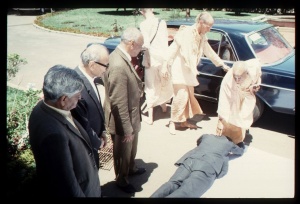CC Antya 1.166 (1975): Difference between revisions
(Vanibot #0027: CCMirror - Mirror CC's 1996 edition to form a basis for 1975) |
(Vanibot #0020: VersionCompareLinker - added a link to the Version Compare feature) |
||
| Line 2: | Line 2: | ||
<div style="float:left">'''[[Sri Caitanya-caritamrta (1975)|Śrī Caitanya-caritāmṛta (1975)]] - [[CC Antya (1975)|Antya-līlā]] - [[CC Antya 1 (1975)|Chapter 1: Śrīla Rūpa Gosvāmī's Second Meeting With the Lord]]'''</div> | <div style="float:left">'''[[Sri Caitanya-caritamrta (1975)|Śrī Caitanya-caritāmṛta (1975)]] - [[CC Antya (1975)|Antya-līlā]] - [[CC Antya 1 (1975)|Chapter 1: Śrīla Rūpa Gosvāmī's Second Meeting With the Lord]]'''</div> | ||
<div style="float:right">[[File:Go-previous.png|link=CC Antya 1.165 (1975)|Antya-līlā 1.165]] '''[[CC Antya 1.165 (1975)|Antya-līlā 1.165]] - [[CC Antya 1.167 (1975)|Antya-līlā 1.167]]''' [[File:Go-next.png|link=CC Antya 1.167 (1975)|Antya-līlā 1.167]]</div> | <div style="float:right">[[File:Go-previous.png|link=CC Antya 1.165 (1975)|Antya-līlā 1.165]] '''[[CC Antya 1.165 (1975)|Antya-līlā 1.165]] - [[CC Antya 1.167 (1975)|Antya-līlā 1.167]]''' [[File:Go-next.png|link=CC Antya 1.167 (1975)|Antya-līlā 1.167]]</div> | ||
{{CompareVersions|CC|Antya 1.166|CC 1975|CC 1996}} | |||
{{RandomImage}} | {{RandomImage}} | ||
==== TEXT 166 ==== | ==== TEXT 166 ==== | ||
<div class="verse"> | <div class="verse"> | ||
:jaṅghādhas-taṭa-saṅgi-dakṣiṇa-padaṁ kiñcid vibhugna- | :jaṅghādhas-taṭa-saṅgi-dakṣiṇa-padaṁ kiñcid vibhugna-trikam- | ||
:sāci-stambhita-kandharaṁ sakhi tiraḥ-sañcāri-netrāñcalam | :sāci-stambhita-kandharaṁ sakhi tiraḥ-sañcāri-netrāñcalam | ||
:vaṁśīṁ kuṭmalite dadhānam adhare lolāṅgulī-saṅgatāṁ | :vaṁśīṁ kuṭmalite dadhānam adhare lolāṅgulī-saṅgatāṁ | ||
:riṅgad-bhrū-bhramaraṁ varāṅgi paramānandaṁ puraḥ | :riṅgad-bhrū-bhramaraṁ varāṅgi paramānandaṁ puraḥ svīkuru | ||
</div> | </div> | ||
| Line 20: | Line 19: | ||
<div class="synonyms"> | <div class="synonyms"> | ||
jaṅghā—of the shin; adhaḥ-taṭa—at the lower border; saṅgi—connected; dakṣiṇa-padam—the right foot; kiñcit—slightly; | jaṅghā—of the shin; adhaḥ-taṭa—at the lower border; saṅgi—connected; dakṣiṇa-padam—the right foot; kiñcit—slightly; vibhugna-trikam—the middle of the body bent in three places; sāci-stumbhita-kandharam—whose neck is fixed in a curve to the side; sakhi—O friend; tiraḥ-sañcāri—roaming sideways; netra-añcalam—whose borders of the eyes; vaṁśīm—flute; kuṭmalite—shut like a flower bud; dadhānam—placing; adhare—on the lips; lolā-aṅgulī-saṅgatām—joined with fingers moving here and there; riṅgat-bhrū—whose slowly moving eyebrows; bhramaram—like bumblebees; varāṅgi—O most beautiful one; paramānandam—the personality of bliss; puraḥ—situated in front; svī-kuru—just accept. | ||
</div> | </div> | ||
| Line 27: | Line 26: | ||
<div class="translation"> | <div class="translation"> | ||
'O most beautiful friend, please accept the Supreme Personality of Godhead, who is standing before you full of transcendental bliss. The borders of His eyes roam from side to side, and His eyebrows move slowly like bumblebees on His lotuslike face. Standing with His right foot placed below the knee of His left leg, the middle of His body curved in three places, and His neck gracefully tilted to the side, He takes His flute to His pursed lips and moves His fingers upon it here and there.' | |||
</div> | </div> | ||
| Line 34: | Line 33: | ||
<div class="purport"> | <div class="purport"> | ||
This verse from the Lalita-mādhava-nāṭaka (4.27), a ten-act play by Śrīla Rūpa Gosvāmī | This verse is from the Lalita-mādhava-nāṭaka (4.27), a ten-act play by Śrīla Rūpa Gosvāmī. The speaker here is Lalitādevī. | ||
</div> | </div> | ||
Latest revision as of 20:13, 26 January 2020

A.C. Bhaktivedanta Swami Prabhupada
TEXT 166
- jaṅghādhas-taṭa-saṅgi-dakṣiṇa-padaṁ kiñcid vibhugna-trikam-
- sāci-stambhita-kandharaṁ sakhi tiraḥ-sañcāri-netrāñcalam
- vaṁśīṁ kuṭmalite dadhānam adhare lolāṅgulī-saṅgatāṁ
- riṅgad-bhrū-bhramaraṁ varāṅgi paramānandaṁ puraḥ svīkuru
SYNONYMS
jaṅghā—of the shin; adhaḥ-taṭa—at the lower border; saṅgi—connected; dakṣiṇa-padam—the right foot; kiñcit—slightly; vibhugna-trikam—the middle of the body bent in three places; sāci-stumbhita-kandharam—whose neck is fixed in a curve to the side; sakhi—O friend; tiraḥ-sañcāri—roaming sideways; netra-añcalam—whose borders of the eyes; vaṁśīm—flute; kuṭmalite—shut like a flower bud; dadhānam—placing; adhare—on the lips; lolā-aṅgulī-saṅgatām—joined with fingers moving here and there; riṅgat-bhrū—whose slowly moving eyebrows; bhramaram—like bumblebees; varāṅgi—O most beautiful one; paramānandam—the personality of bliss; puraḥ—situated in front; svī-kuru—just accept.
TRANSLATION
'O most beautiful friend, please accept the Supreme Personality of Godhead, who is standing before you full of transcendental bliss. The borders of His eyes roam from side to side, and His eyebrows move slowly like bumblebees on His lotuslike face. Standing with His right foot placed below the knee of His left leg, the middle of His body curved in three places, and His neck gracefully tilted to the side, He takes His flute to His pursed lips and moves His fingers upon it here and there.'
PURPORT
This verse is from the Lalita-mādhava-nāṭaka (4.27), a ten-act play by Śrīla Rūpa Gosvāmī. The speaker here is Lalitādevī.